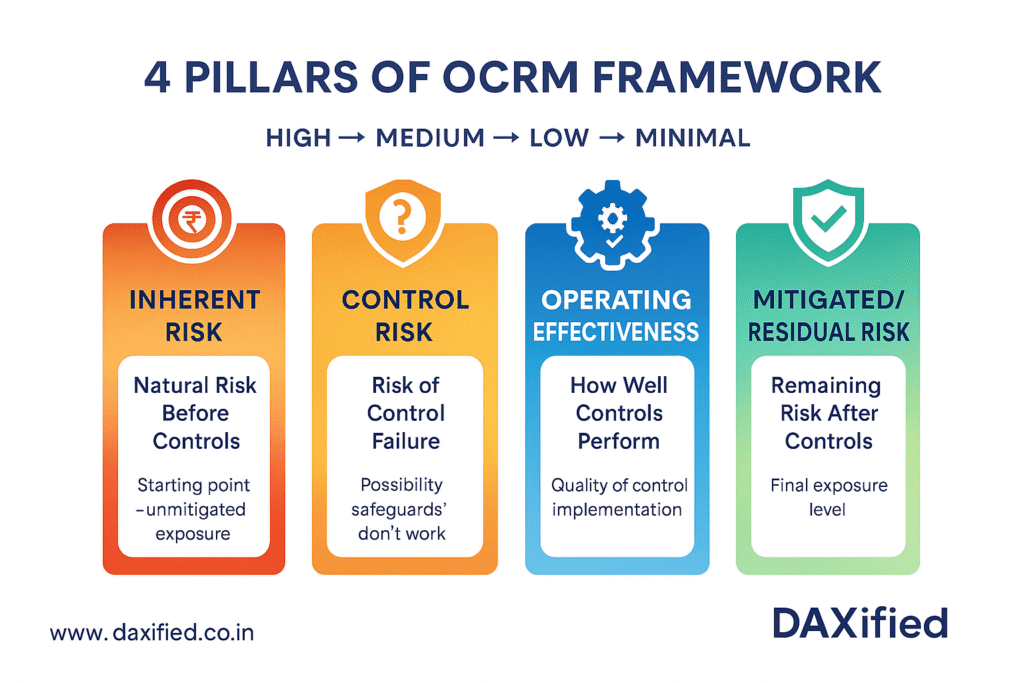💡 OCRM Framework Overview: Understanding the relationship between Inherent Risk (natural business exposure), Control Risk (protective measure failures), Operating Effectiveness (control performance), and Mitigated Risk (remaining exposure) is crucial for effective risk management. This comprehensive framework visualization demonstrates how systematic risk reduction transforms high-impact Inherent Risk into manageable Residual Risk:

“Understanding OCRM requires a visual approach. The framework below demonstrates how systematic risk management transforms high-exposure scenarios into controlled, manageable outcomes through proven methodologies.”
OCRM Explained
Understanding Risk Management Through Real Currency Hedge Examples
Explore More on DAXifiedDemystifying the Overall Control Risk Model
Learn how the Overall Control Risk Model (OCRM) helps organizations measure and manage risks using practical currency hedging examples that everyone can understand.
🎯 What is OCRM and Why Should You Care?
Imagine you’re planning a trip abroad and need to exchange money. The exchange rate keeps fluctuating, and you’re worried about losing money. How do you protect yourself? This is exactly what businesses face with much larger amounts, and the Overall Control Risk Model (OCRM) helps them navigate these challenges.
OCRM in Simple Terms: It’s a framework that helps measure different types of risks in a systematic way – from the natural risk in any situation to the risk that remains even after implementing protective measures.
The DAXified approach to explaining OCRM focuses on four key elements that work together like layers of protection:
- Inherent Risk – The natural risk before any protection
- Control Risk – The chance your safety measures fail
- Operating Effectiveness – How well those measures work in practice
- Mitigated/Residual Risk – The remaining exposure after all measures
🔍 The Four Pillars of OCRM
Let’s break down each element using a real-world currency hedging scenario that businesses face every day.
Inherent Risk
Definition: The starting risk before any protection measures.
Currency Example:
Your company expects to receive $100,000 from a US client in 3 months. Today’s rate: ₹85 per dollar.
If the dollar falls to ₹80, you lose ₹5 per dollar = ₹500,000 potential loss
This ₹500,000 is your inherent risk.
Control Risk
Definition: The risk that your protective safeguards fail to work.
Currency Example:
You buy a forward contract to sell $100,000 at ₹85 (hedge protection).
But what if:
- Bank documentation has errors
- Contract terms are miscalculated
- Settlement process fails
This possibility is your control risk.
Operating Effectiveness
Definition: How well the safeguard actually performs when tested.
Currency Example:
You implement monitoring processes:
- Regular verification of contract terms
- Monthly bank confirmations
- Treasury team oversight
Result: High operating effectiveness = very low chance of hedge failing.
Mitigated (Residual) Risk
Definition: The risk that remains after all controls work properly.
Currency Example:
Your forward contract covers only $90,000 due to bank limits.
The remaining $10,000 is unhedged.
If dollar drops ₹5: $10,000 × ₹5 = ₹50,000 residual risk
This is your mitigated/residual risk.
Internal Audit Perspective on OCRM
From an Internal Audit standpoint, OCRM provides a structured approach to evaluate risk management effectiveness. Internal Audit teams can use this framework to assess whether management has properly identified inherent risks, implemented appropriate controls, and accurately measured residual exposures. This systematic evaluation helps ensure that risk management practices align with organizational risk appetite and regulatory requirements.
🔗 How OCRM Ties It All Together
The beauty of OCRM lies in its systematic approach to risk measurement. Here’s how our currency hedge example maps to the complete framework:
| OCRM Stage | Currency Hedge Example | Risk Assessment | Financial Impact |
|---|---|---|---|
| Inherent Risk | $100,000 exposure with no hedge protection | High – Full market exposure | ₹5,00,000 |
| Control Risk | Forward contract in place, but may fail | Medium – Depends on control design | Variable |
| Operating Effectiveness | Regular verification and monitoring | Satisfactory – Well-designed processes | Very Low |
| Mitigated Risk | $10,000 unhedged due to contract limits | Low – Minimal remaining exposure | ₹50,000 |
Key Insight: OCRM reduces risk from ₹500,000 to ₹50,000 – a 90% risk reduction through systematic risk management!
💡 Why Currency Hedging Makes OCRM Clear
This analogy works exceptionally well for explaining OCRM because:
🌍 Universal Understanding
Everyone understands money and exchange rates. It makes abstract risk concepts tangible and relatable, whether you’re in finance, operations, or management.
📊 Quantifiable Impact
Numbers tell a clear story. You can see exactly how much risk exists “before and after” implementing controls, making the value of risk management visible.
🎯 Clear Stages
Each OCRM stage has a distinct, logical step in the hedging process, making it easy to understand how different types of risk interact with each other.
🔄 Real Business Application
This isn’t just theoretical – companies actually use currency hedging, making the example practical and applicable to real business scenarios.
🚀 Taking OCRM Further: Advanced Applications
Once you understand the basics through our currency example, you can apply OCRM to virtually any risk scenario:
Cybersecurity Risk Management
Inherent Risk: Potential data breach affecting 100,000 customer records
Control Risk: Firewall and encryption might fail
Operating Effectiveness: Regular security testing and monitoring
Mitigated Risk: Residual exposure to targeted attacks
Supply Chain Risk Management
Inherent Risk: Production shutdown if key supplier fails
Control Risk: Backup suppliers might not deliver on time
Operating Effectiveness: Regular supplier audits and relationship management
Mitigated Risk: Short-term disruption despite backup plans
Join Our Learning Community
Ready to dive deeper into risk management, data analytics, and business intelligence? Connect with fellow learners and industry experts!
Join thousands of professionals advancing their skills with DAXified
